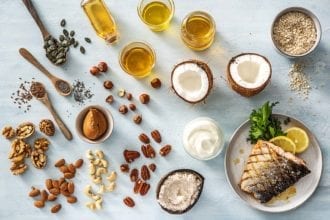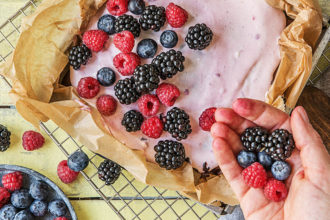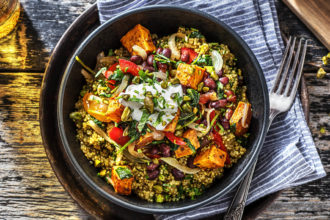How To Cut Down Your Sugar Intake With Six Natural Sugar Swaps
November 19, 2018Sugar is a carbohydrate found naturally in many different foods, from lactose in milk to fructose in fruit and honey. There are two types of sugar: naturally occurring sugar (like lactose in milk) and added or ‘free’ sugars that include refined table sugar as well as concentrated sources like fruit juice.
Although sugar is natural, it does have downsides, such as being high in calories without the fibre or protein to nourish your body. A high sugar intake causes our blood sugar levels to spike, giving us that sugar-rush ‘high’ followed by a crashing slump that leaves us feeling tired, irritable and craving even more sugary foods. It’s a destructive cycle that may be contributing to our weight problems as well as health conditions like diabetes, hypertension, cardiovascular or liver disease and lipid metabolism disorders.
If you have an active lifestyle and exercise regularly, small amounts of sugar in your diet can help provide energy to fuel your muscles and keep your brain active. The real problem for a lot of us is that many of the foods we eat – processed foods in particular – contain lots of ‘hidden’ sugars. A tablespoon of Ketchup, for example, contains (on average) a whole cube of sugar. Imagine you were giving 9 tablespoons of ketchup for your lunch or dinner. That would already cover the amount of sugar that the World Health Organization cites as a daily maximum (about 25 grams).
What sugar alternatives are there?
There are a number of sugar alternatives that are available if you want to reduce your sugar intake. Here are the most common:
1. Coconut Blossom Sugar
Coconut blossom sugar comes from the flower nectar of the coconut palm. It has a lower impact on the blood sugar level than table sugar and contains many nutrients, such as zinc, iron, magnesium and also has a slight antioxidant effect.
Coconut blossom sugar has a delicious caramel taste, which works particularly well when baking. In addition, you can use it in the same amount as sugar, which makes swapping it out super straightforward.
Important: Pay attention to the list of ingredients when buying coconut sugar, as it is often mixed with cheaper ingredients such as cane sugar, maltodextrin or colouring ingredients. Unfortunately, the eco-balance does not look too good due to the long transport route, but here you can create a small balance through sustainably produced goods (mostly organic products).
2. Maple Syrup
One of the liquid and natural sugar alternatives is maple syrup. Originating from Canada, the syrup is extracted from the Canadian maple trees every year. It has about 60-70% of the sweetness of sugar and a sweet-tart taste. In addition, maple syrup also carries calcium, potassium, magnesium and iron. The lighter the syrup, the higher the quality.
Important: Maple syrup contains a lot of fructose and is therefore not suitable for people with fructose intolerance. If you use the syrup for baking, reduce the amount of oil or milk slightly, otherwise, your dough will become too liquid.
3. Honey
Honey is one of the oldest sugar alternatives in the world. Although it contains few vitamins and minerals, it does contain a number of antioxidants and bioactive substances that have anti-inflammatory and antibacterial properties. Honey sweetens more than table sugar, so use less than you would if adding white sugar.
Important: Do not heat honey above 40 degrees as this will disable its healthy, bioactive ingredients. The fact that honey is sweeter than sugar and also contains quite a lot of glucose and fructose, means that it is unfortunately not as well suited as a 1: 1 replacement for sugar (and also for diabetics)
4. Agave Syrup
Agave syrup is a syrup from the juice of the agave plant. Agave syrup has more sweetening power than sugar and has the mildest taste of our three liquid sugar alternatives. It’s good for baking (make sure to adjust the remaining amount of liquid) and is also readily available in supermarkets.
Important: agave syrup consists of 80% fructose and is therefore not recommended for fructose intolerance. I like to use it at the moment in my homemade granola, but quite sparingly.
5. Dried fruit
Dried apricots, prunes, figs, dates, raisins and pastes made from them contain naturally occurring sugars. They also contain vitamins and minerals. However, their sweetness is quite high and they bring their own taste, so use them sparingly if possible.
Important: Some dried fruits, such as plums, have a slightly laxative effect when consumed more, so never use too much. A great addition to homemade muesli or a nut mixture to counteract the afternoon slumps.
6. Fresh fruits
Fruits such as bananas, pears and grapes bring their own fruit sugar and also valuable fibre, vitamins and minerals. You can, therefore, use them entirely in place of sugar. This works especially well if you purée the fruits to use in baking. Try our vegan banana ‘nice’ cream or 3-ingredient pancakes for a delicious sugar-free treat.
Important: Pay attention to the taste the fresh fruits bring. In addition, fruit contains a lot of fructose, so you should not eat more than two servings a day. Just when you start to eat less sugar, you should use fruits (and dried fruits) rather sparingly to neutralize your sense of taste
6 easy ways to cut down on sugar
Making a few adjustments to your diet can help you cut down on unnecessary sugar consumption:
- Avoid low-fat ‘diet’ foods which tend to be high in sugars. Instead, have smaller portions of the regular versions.
- Be wary of ‘sugar-free’ foods. These often contain artificial sweeteners like sucralose, saccharin and aspartame which can lead to overeating.
- Balance your carbohydrate intake with lean protein like fish, chicken and turkey. Protein foods slow stomach emptying which helps manage cravings. Explore our recipe archive here.
- Swap white bread, rice and pasta for wholegrain versions like oats, rye and wholemeal bread, brown rice and pasta.
- Reduce the sugar in recipes and drinks and add spices to boost flavour and taste.
- For a pick-me-up, have a piece of whole fruit with a handful of nuts or a small bowl of Greek yoghurt. Both contain protein which helps balance blood sugar and energy levels.
[button content=”Find Healthy Recipes Here” color=”green” text=”black” url=”https://www.hellofresh.co.uk/recipes/” openin=”_self”]













